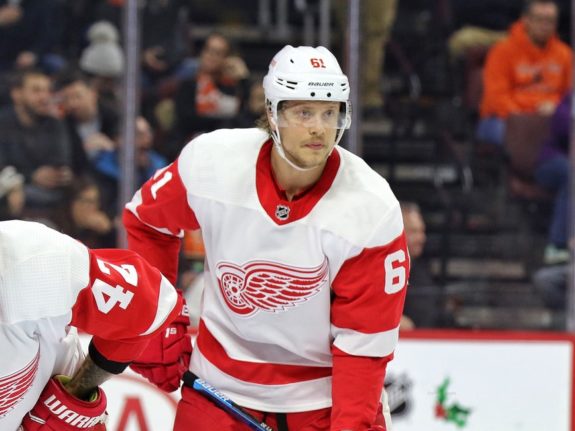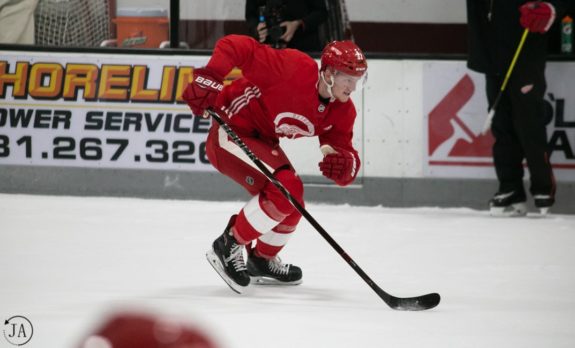Looking at the Detroit Red Wings’ offensive numbers, a few stats leap off the page. Not surprising, the majority of the offense is generated by Dylan Larkin’s line with Anthony Mantha, and Tyler Bertuzzi. They lead the team in goals, assists, and points. Having said that, the sudden drop in production for almost every other line on the roster is shocking. How is Luke Glendening the most efficient offensive weapon behind the top line? Why is Andreas Athanasiou still goalless? And why hasn’t Evgeny Svechnikov been given a chance to play?
The Red Wings need to solve their depth problems before they stagnate. We’ll take a closer look at what’s worked and what hasn’t, the long-term effects of a weak offense, and some solutions that could create positive results.
What’s Working and What Isn’t
Surprisingly, the fourth line of Justin Abdelkader, Jacob De la Rose, and Darren Helm has been the most efficient line behind Larkin’s. They lean heavily on their role as the grinding line, hitting hard and opening up lanes for scoring opportunities. Abdelkader, specifically, seems to have a fire lit under him. He’s scrappier, hungrier, and more energetic than he’s been in years. It’s possible that Abdelkader and other veterans were told they had to fight for their spots; right now, they’re doing a wonderful job of that.
Besides the Abdelkader line, very little can be said of the other lines. While Glendening has worked incredibly hard and been efficient, he’s unable to keep up with the pace of his linemates on the second line. Athanasiou and Taro Hirose, need a play-making threat who can help them generate offensive opportunities. Glendening, while leading the rest of the offense in points behind the Larkin line, won’t be able to keep up this production for a afull NHL season.
Offensive Depth Could Spell Red Wings’ Doom
If the disastrous lack of depth isn’t solved soon, it may cause the rest of the offense to stagnate as well. What happens when a high-powered team shuts down the Larkin line? Will the team be forced to rely on the Abdelkader line for scoring chances? A number of players will need to step up in order to shoulder some of the offensive burden put on the top line. Secondary scoring is what sets average teams apart from the excellent ones; without depth, the Red Wings are doomed. While the thought of a high-round draft pick is exciting, relying on one offensive line will have long-term repercussions.

Solving the Secondary Scoring Snafu
There are two paths the team could take in order to fix this problem. The first is a roster shake-up. One of head coach Jeff Blashill’s favorite techniques is to blend lines and shift players around to better acclimate them to linemates with similar skill sets. Placing a two-way center like Frans Nielsen on the second line, pushing Athanasiou to the wing, could balance the second line’s play-making woes. This would free up space on the third line for Glendening to shoulder faceoff responsibilities alongside Adam Erne and Valtteri Filppula, opening up more space for the third line to generate chances.
The other solution is to give a rookie or a prospect a chance. Svechnikov was called up a few days into the season and still hasn’t had a chance to play a game. Considering the Red Wings’ logjam on offensive, he’ll likely be sent back to the American Hockey League’s Grand Rapids Griffins sooner rather than later. If, however, an injury or a healthy scratch from an underwhelming player occurs, Svechnikov should receive a chance to solidify his spot on the roster. A fresh face and a new set of skills could help the Red Wings generate newer, more dynamic secondary scoring opportunities as the season unfolds.

If you were coach Blashill, how would you solve the secondary scoring? Let us know in the comments!